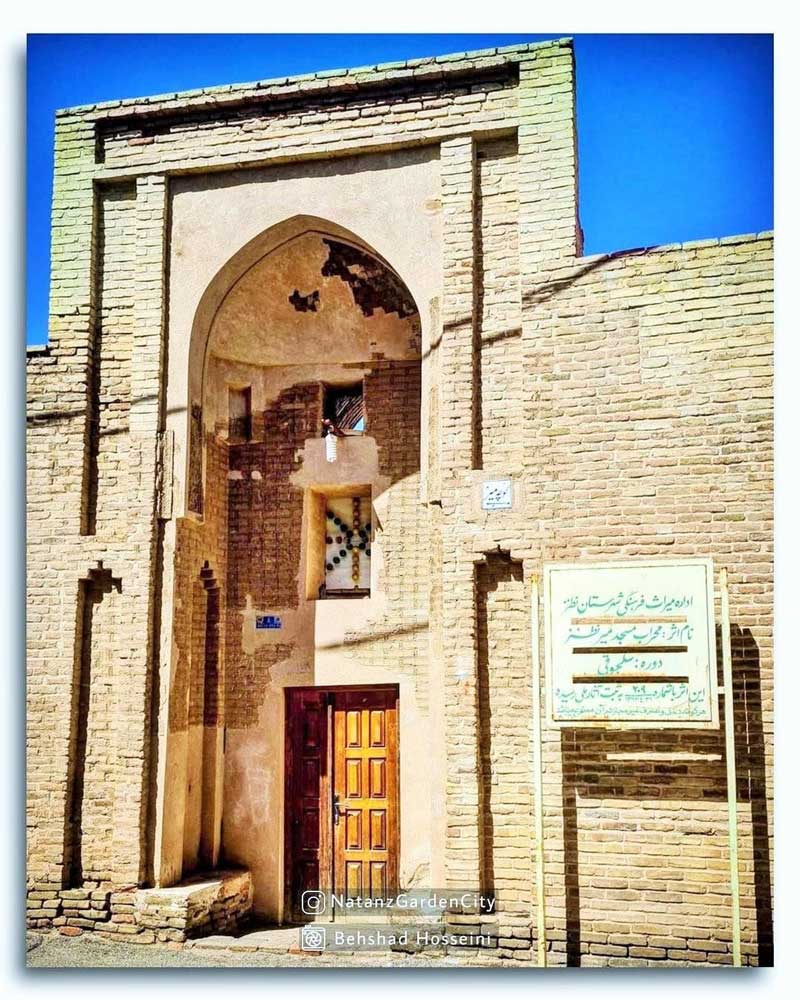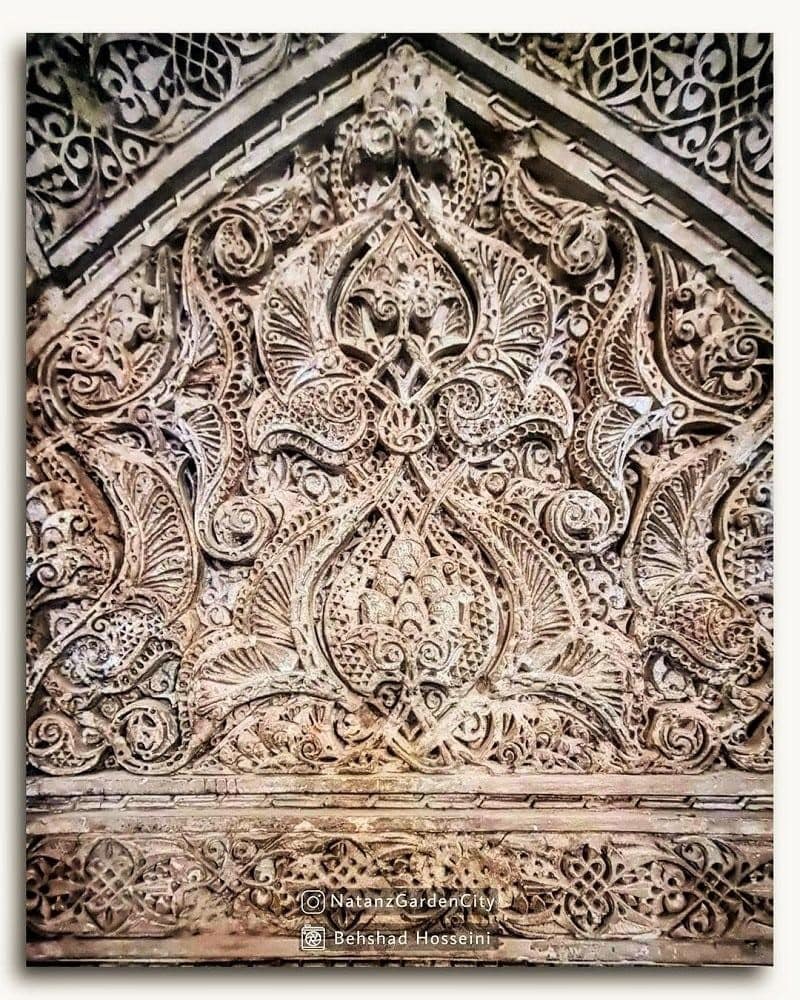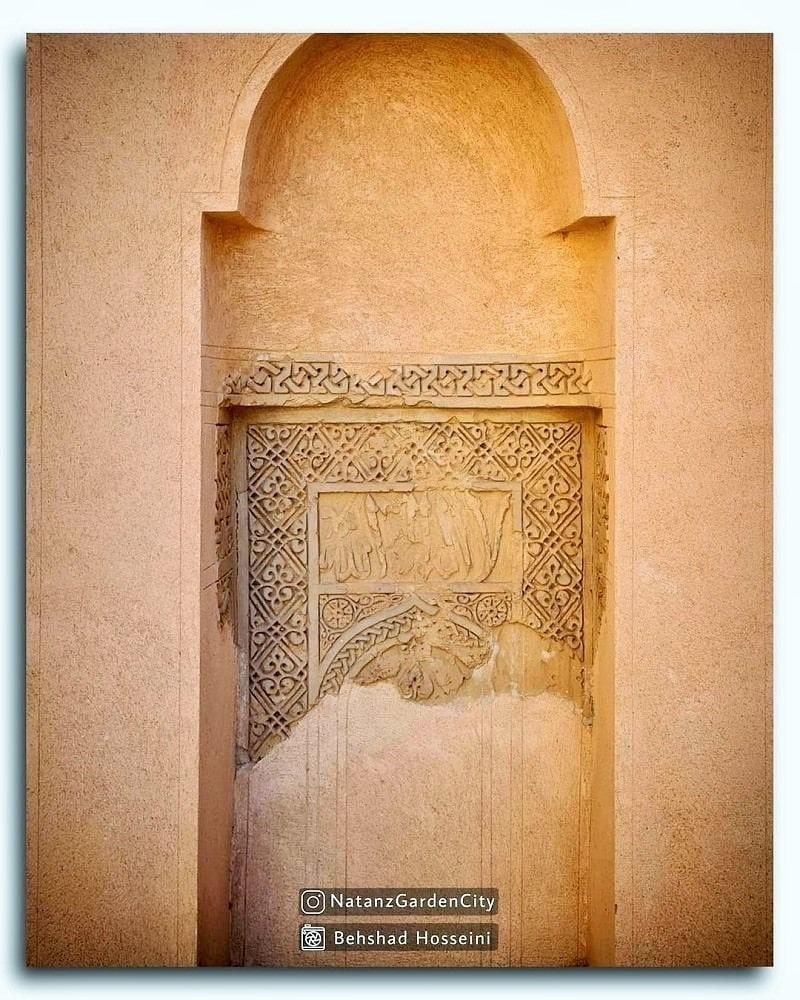
Natanz is one of the beautiful cities in Isfahan province also known as a garden city. The historical garden city of Natanz contains numerous historical monuments, many of which have been registered on the Iran national heritage list. Among these historical sites, we can mention Mir Mosque of Natanz with unique decorations and characteristics.
Natanz Mir Mosque is located on Malik Ashtar St. in one of the west side neighborhoods of Natanz, inside an alley called “Mir Alley”. The mosque building dates back to the late Seljuk era. This national heritage site was added to the Iran National Heritage List in 1934.
Mir Mosque of Natanz Design and Architectural Features

This mosque has a high entrance portal made of bricks. The mosque entrance has a barrel-vault arch. There are plasterwork decorations on the arch edges, embellished with relief inscriptions. Over time and because of degradation due to weather effects, these inscriptions have faded and are unreadable for the most part.
There are two false arches to the two sides of the main entrance, built on two floors. Currently, the false arch on the second floor is in ruins.
In addition to that, there are two other false arches in the entrance portal’s interior on both sides. These arches are made of bricks and serve as niches in the wall.
After passing through the entrance portal, we enter a corridor approximately one meter wide and 6 meters long. There is a Shabestan (prayer hall) on the left side of this corridor, with a square shaped design and the length of its sides is 6 meters. The prayer hall area is divided into 9 parts by 4 columns.
There are 9 small uniform domes on the roof of the prayer hall. These domes are built on 4 broad square columns.
Next to this prayer hall is a vestibule that connects to another prayer hall. This domed prayer hall was recently added to the mosque, and is located below the ground level and serves as a prayer area.
One of the prominent features of Mir Mosque of Natanz is its two Mihrabs (altars) on two floors. The main mihrab of the mosque was built in the late Seljuk and early Timurid period, with a height of about 84 cm.
The mihrab decorations, such as plasterwork embellishments and flower and bush motifs, add to its elegance. The Arabesque designs on the altar are similar to the decorations of the Seljuk and Mongol era architecture, but have more elegant and refined details.
This mihrab has two inscriptions featuring verses from the Quran, carved in relief style and in thuluth script. One of these inscriptions is inside of the mihrab’s false arch on the lower niche, and the other one is on the edge of the mihrab.
Evidence Suggesting Mir Mosque of Natanz Was a Two-Story Building

There is evidence in the current structure of the Natanz Mir Mosque that suggests the mosque had two stories in the past. Below are some of them:
The presence of a mihrab on the roof of the mosque: There is a second mihrab on the mosque roof directly above the main mihrab. This mihrab has similar design features as the main mihrab, but is smaller in size. The dimensions of this altar are about 48 x 67 cm.
Since the mihrab has been exposed to wind and rain and other corrosive weather conditions, most of its parts have been destroyed. This mihrab also has decorations similar to the main mihrab , such as plasterwork and flower and bush designs. There is an inscription reading “La ilaha ila Allah” carved on the plasterwork.
The entrance portal is higher than the roof level: the entrance portal of Mir Mosque of Natanz is slightly higher than the roof level. Therefore, it is speculated that the mosque had two floors in the past and the second floor has been destroyed. In addition, archaeological studies have found that the original mosque building was bigger than the current standing structure.
Visit Mir Mosque of Natanz in Isfahan
Different sections of Natanz Mir Mosque have been destroyed over time. This building has been renovated many times in different historical periods. Nevertheless, this mosque is still one of the valuable Natanz historical attractions that you can visit.
If you travel to Natanz on an Iran tour package or personally, do not miss visiting this valuable historical site. The architectural features of this mosque, including its two mihrabs on two stories, are unique historical remains. Many domestic and international travelers visit Natanz every year to visit this mosque.
Destination Iran invites you to visit Mir Mosque in Natanz in addition to other Natanz Tourist Attractions.
Where is Mir Mosque of Natanz?
Mir Mosque is one of the historical monuments of Isfahan province, which is located in Natanz city, Malik Ashtar Street and in Mir Alley. You can see the exact location of this mosque below:
Frequently Asked Questions About Mir Mosque of Natanz
If you can not find the answer to your question here, leave us a comment in the comments section below this post and ask your question. We will answer it as soon as possible.
How old is Mir Mosque of Natanz?
The mosque’s main building dates back to the late Seljuk era while some sections were added during the early Timurid era.
What is the main architectural features of the mihrab of Natanz Mir Mosque?
This mosque has the highest mihrab (altar) with a height of 84 meters and a width of 64 meters. It features plasterwork decorations with flower and bush designs, has two relief inscriptions in thuluth script presenting verses of the Quran.
How old are the historical mihrabs in Mir Mosque of Natanz?
Since parts of the inscriptions of these two altars have been distorted and the exact construction date is unknown, there are various theories about the possible date of the construction of the mihrabs. Some archeological researchers consider them to belong to the second half of the 15th century AD.













